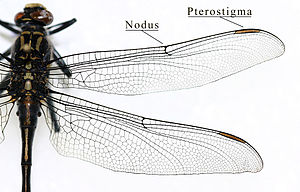Pterostigma: Difference between revisions
Content deleted Content added
m robot Adding: pl:Pterostygma |
Chuunen Baka (talk | contribs) m convert inline ref to formal cite |
||
| Line 1: | Line 1: | ||
{{Unreferenced stub|auto=yes|date=December 2009}} |
{{Unreferenced stub|auto=yes|date=December 2009}} |
||
[[Image:IC Gomphidae wing.jpg|thumb|300px|Wing of a dragonfly of the family [[Gomphidae]], showing the pterostigma]] |
[[Image:IC Gomphidae wing.jpg|thumb|300px|Wing of a dragonfly of the family [[Gomphidae]], showing the pterostigma]] |
||
The '''pterostigma''' is a cell in the outer [[insect wing|wing]] of [[insect]]s which is often thickened or coloured and so stands out from other cells. It is particularly noticeable in [[dragonfly|dragonflies]], but present also in other insect groups, such as [[snakefly|snakeflies]], [[hymenoptera]]ns and [[megaloptera]]ns. |
The '''pterostigma''' is a cell in the outer [[insect wing|wing]] of [[insect]]s which is often thickened or coloured and so stands out from other cells. It is particularly noticeable in [[dragonfly|dragonflies]], but present also in other insect groups, such as [[snakefly|snakeflies]], [[hymenoptera]]ns and [[megaloptera]]ns.<ref>{{cite web|title=Definition of Pterostigma|url=http://www.amentsoc.org/insects/glossary/terms/pterostigma|publisher=[[Amateur Entomologists' Society]]|accessdate=20 September 2010}}</ref> |
||
The purpose of the pterostigma, being a heavier section of the wing in comparison to nearby sections, is to assist in gliding. Without the pterostigma, self-exciting vibrations would set in on the wing after a certain critical speed, making gliding impossible. |
|||
The purpose of the pterostigma, being a heavier section of the wing in comparison to nearby sections, is to assist in gliding. Without the pterostigma, self-exciting vibrations would set in on the wing after a certain critical speed, making gliding impossible. Tests show that with the pterostigma, the critical gliding speed is increased 10-25% on one species of dragonfly.<ref>{{cite journal|last=Norberg|first=R. Åke|title=The pterostigma of insect wings an inertial regulator of wing pitch |journal=Journal of Comparative Physiology A: Neuroethology, Sensory, Neural, and Behavioral Physiology |volume=81|issue=1|pages=9-22|doi=10.1007/BF00693547}}</ref> |
|||
Tests by R. Åke Norberg, Department of Zoology, University of Göteborg, Göteborg, Sweden, show that with the pterostigma, the critical gliding speed is increased 10-25% on one species of dragonfly. |
|||
==References== |
|||
{{reflist}} |
|||
[[Category:Arthropod anatomy]] |
[[Category:Arthropod anatomy]] |
||
Revision as of 13:03, 20 September 2010

The pterostigma is a cell in the outer wing of insects which is often thickened or coloured and so stands out from other cells. It is particularly noticeable in dragonflies, but present also in other insect groups, such as snakeflies, hymenopterans and megalopterans.[1]
The purpose of the pterostigma, being a heavier section of the wing in comparison to nearby sections, is to assist in gliding. Without the pterostigma, self-exciting vibrations would set in on the wing after a certain critical speed, making gliding impossible. Tests show that with the pterostigma, the critical gliding speed is increased 10-25% on one species of dragonfly.[2]
References
- ^ "Definition of Pterostigma". Amateur Entomologists' Society. Retrieved 20 September 2010.
- ^ Norberg, R. Åke. "The pterostigma of insect wings an inertial regulator of wing pitch". Journal of Comparative Physiology A: Neuroethology, Sensory, Neural, and Behavioral Physiology. 81 (1): 9–22. doi:10.1007/BF00693547.
